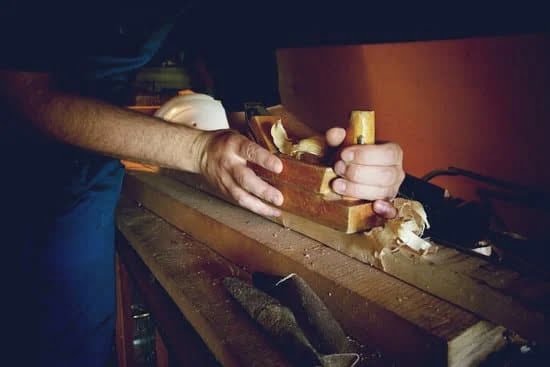Are you looking to elevate your woodworking projects to the next level? In this article, we’ll explore the ins and outs of using Sketchup 2017 for woodworking. From setting up the software to creating 3D models and utilizing precise measurements, we will cover everything you need to know to make the most out of this powerful tool for your woodworking endeavors.
Sketchup 2017 is a versatile and user-friendly software that can enhance your woodworking experience. Whether you’re a beginner or an experienced woodworker, learning how to use Sketchup 2017 can be incredibly beneficial. This article will serve as a comprehensive guide to help you navigate through the basic tools, advanced techniques, and useful plugins that Sketchup 2017 has to offer for woodworking projects.
In the following sections, we will dive into setting up Sketchup 2017 specifically for woodworking, understanding its basic tools and features, creating 3D models for woodworking projects, using precise measurements and dimensions, as well as importing and exporting models. Additionally, we will provide tips and tricks for efficient woodworking with Sketchup 2017 and explore advanced techniques and plugins.
So whether you’re looking to design furniture, create custom cabinetry, or tackle any other woodworking project, Sketchup 2017 has got you covered. Let’s get started.
Setting Up Sketchup 2017 for Woodworking Projects
Sketchup 2017 is a powerful tool for woodworking projects, allowing woodworkers to create detailed 3D models of their designs and efficiently plan their projects. Before getting started with using Sketchup 2017 for woodworking, it’s important to set up the software to best suit your needs.
Customizing Toolbars and Menus
One of the first steps in setting up Sketchup 2017 for woodworking is customizing the toolbars and menus. This allows woodworkers to have easy access to the tools and features they use most frequently, making their workflow more efficient. By organizing the toolbar and menu layout according to your specific woodworking needs, you can streamline the design process and focus on creating accurate models.
Adjusting Units and Measurements
Woodworking often requires precise measurements, so it’s essential to adjust the units and measurements within Sketchup 2017 to align with your woodworking standards. Whether you work in inches or millimeters, setting up the correct units will ensure that your designs accurately reflect the dimensions of your woodworking projects. Understanding how to customize these settings will make it easier to visualize how your design will translate into a physical object.
Installing Relevant Plugins
In addition to customizing the interface and measurements, installing relevant plugins can enhance your experience with Sketchup 2017 for woodworking. There are various plugins available that cater specifically to woodworkers, offering specialized tools such as dovetail joints or mortise and tenon joints.
These plugins can expand Sketchup’s capabilities for woodworking projects, providing additional features that streamline the design process and improve overall accuracy. Knowing which plugins are best suited for woodworking will help maximize efficiency when using Sketchup 2017 for woodworking projects.
Understanding the Basic Tools and Features in Sketchup 2017 for Woodworking
When it comes to woodworking, Sketchup 2017 offers a variety of basic tools and features that can make the design process easier and more efficient. Familiarizing yourself with these tools is essential for creating accurate and detailed woodworking projects.
One of the key features in Sketchup 2017 for woodworking is the ability to create precise shapes and dimensions. The Line, Rectangle, Circle, and Arc tools allow you to create basic shapes that can be manipulated and modified to fit your specific woodworking needs. Additionally, the Push/Pull tool allows you to easily extrude or recess surfaces, making it ideal for creating intricate woodworking designs.
In addition to basic shape creation, Sketchup 2017 also offers a range of modification tools that are essential for woodworking projects. The Move, Rotate, Scale, and Offset tools allow you to manipulate your designs with precision and ease. These tools are particularly useful when refining your woodworking models to ensure they meet your exact specifications.
Lastly, understanding how to use layers and components in Sketchup 2017 is crucial for organizing complex woodworking projects. By grouping related elements into components and organizing them on separate layers, you can streamline your workflow and make it easier to edit and modify your designs as needed. Mastering these basic tools and features will provide a solid foundation for using Sketchup 2017 for woodworking projects.
Creating 3D Models for Woodworking Projects in Sketchup 2017
Sketchup 2017 is a powerful tool for creating 3D models for woodworking projects. Whether you’re designing furniture, cabinets, or other woodworking items, Sketchup 2017 provides the tools and features needed to bring your ideas to life in 3D. In this section, we will explore how to create 3D models for woodworking projects using Sketchup 2017.
To get started with creating 3D models for woodworking projects in Sketchup 2017, follow these steps:
- Open Sketchup 2017 and choose the template that best suits your project, such as “Woodworking inches” or “Woodworking millimeters.”
- Use the basic drawing tools to create the shapes and components needed for your woodworking project. This includes tools such as the Line tool, Rectangle tool, Circle tool, and others.
- Utilize the Push/Pull tool to extrude 2D shapes into 3D forms. This allows you to give depth and dimension to your woodworking models.
Once you have mastered the basic tools and techniques for creating 3D models in Sketchup 2017, you can move on to more advanced features such as component creation, texturing, and adding details to your woodworking designs. With practice and patience, you can use Sketchup 2017 to bring your woodworking ideas from concept to reality in stunning 3D visuals.
By mastering the basics of creating 3D models in Sketchup 2017 for woodworking projects, woodworkers can streamline their design process and visualize their creations before bringing them to life in the workshop. Whether you’re a beginner or an experienced woodworker, Sketchup 2017 provides a user-friendly platform for transforming your ideas into detailed and accurate 3D models that are essential for successful woodworking projects.
Using Sketchup 2017 for Precise Measurements and Dimensions in Woodworking
When it comes to woodworking, precise measurements and dimensions are crucial to the success of any project. Sketchup 2017 offers a range of tools and features that make it easier for woodworkers to ensure accuracy in their designs. In this section, we will explore how to use Sketchup 2017 for precise measurements and dimensions in woodworking.
One of the key tools within Sketchup 2017 for achieving precise measurements is the Tape Measure tool. This tool allows woodworkers to accurately measure distances, which is essential for creating furniture, cabinets, or other woodworking projects. Additionally, the Dimension tool in Sketchup 2017 allows users to add precise dimensions to their models, making it easier to visualize the final product and ensure that all components fit together seamlessly.
Another useful feature in Sketchup 2017 for achieving precise measurements is the ability to input exact dimensions when creating or editing components. This level of precision ensures that every part of a woodworking project is accurately sized and aligned, reducing potential errors during the construction process.
In addition to these basic measurement tools, Sketchup 2017 also offers plugins and extensions specifically designed for woodworking professionals. These plugins can further enhance the precision and efficiency of woodworking projects by providing advanced measurement capabilities, such as angle calculations and complex joint designs.
| SketchUp Tool or Feature | Function |
|---|---|
| Tape Measure tool | Accurately measure distances in models |
| Dimension tool | Add precise dimensions to models |
| Component Dimensions Input | Allow user input exact dimensions when creating or editing components |
Importing and Exporting Sketchup 2017 Models for Woodworking
Woodworking projects often require the use of various software tools to design, plan, and visualize the final product. Sketchup 2017 is a powerful tool for woodworking enthusiasts, as it allows for the creation of detailed 3D models and precise measurements. Additionally, Sketchup 2017 provides the functionality to import and export models, making it a versatile choice for woodworking projects.
When importing existing models into Sketchup 2017, users have the option to bring in files from other design software or even download components from the 3D Warehouse. This can save time and effort by allowing woodworkers to incorporate pre-made elements such as furniture pieces, architectural details, or decorative items into their projects.
On the other hand, exporting Sketchup 2017 models is essential for sharing designs with clients, collaborators, or manufacturers. Whether creating technical drawings for production or sharing virtual walkthroughs of the project, exporting models in different file formats such as PDFs or CAD files ensures clear communication and execution of woodworking plans.
Some tips on importing and exporting using Sketchup 2017 include:
- When importing models, ensure that they are compatible with Sketchup 2017 by checking file formats and compatibility requirements.
- Before exporting a model from Sketchup 2017, double-check dimensions and measurements to ensure accurate representation in other software programs.
- Consider using plugins or extensions for enhanced import/export capabilities, such as those designed specifically for woodworking projects.
With these considerations in mind, woodworkers can leverage the power of Sketchup 2017 to not only create stunning 3D models but also seamlessly integrate them into their woodworking processes through importing and exporting functionalities.
Tips and Tricks for Efficient and Effective Woodworking With Sketchup 2017
Utilizing Components and Groups
One of the most helpful tips for efficient woodworking in Sketchup 2017 is to make use of components and groups. By creating components for repetitive elements such as table legs or chair backs, you can easily duplicate and modify these elements without having to recreate them each time. Additionally, grouping related parts together makes it easier to manipulate and edit multiple elements at once, saving time and effort in the design process.
Keyboard Shortcuts and Customization
To work more efficiently in Sketchup 2017 for woodworking projects, it’s essential to familiarize yourself with keyboard shortcuts for frequently used tools. Learning and using shortcuts for actions like drawing lines, creating shapes, and navigating the workspace can significantly speed up your workflow. Furthermore, consider customizing the toolbar to include the most frequently used tools specific to woodworking, making them easily accessible for quick use.
Utilizing Layers Effectively
Another tip for effective woodworking in Sketchup 2017 is to utilize layers properly. Organizing components and groups into different layers can help streamline the modeling process and make it easier to control visibility and editing of specific elements. By assigning components to separate layers based on their function or purpose, you can maintain a clear and organized model that is easier to work with throughout the project.
By implementing these tips and tricks, woodworkers can improve their efficiency and productivity when using Sketchup 2017 for their woodworking projects. Understanding how to use sketchup 2017 for woodworking will greatly benefit woodworkers who want to streamline their design process while maintaining precision and accuracy in their models.
Advanced Techniques and Plugins for Woodworking in Sketchup 2017
In conclusion, learning how to use Sketchup 2017 for woodworking can greatly benefit both amateur and professional woodworkers. With its user-friendly interface and powerful tools, Sketchup 2017 provides a versatile platform for creating detailed 3D models, precise measurements, and efficient project planning. By following the steps outlined in this guide, woodworkers can easily set up Sketchup 2017 for their projects and navigate its basic tools and features.
Additionally, the advanced techniques and plugins available in Sketchup 2017 offer even more possibilities for woodworking projects. From complex joinery to intricate details, these advanced features can elevate the quality and creativity of woodworking designs. Importing and exporting models in Sketchup 2017 also allows woodworkers to collaborate with others or bring their creations to life using other software or manufacturing technologies.
Furthermore, by implementing the tips and tricks provided in this article, woodworkers can enhance their efficiency and effectiveness when using Sketchup 2017. Whether it’s using shortcuts, optimizing workspace layout, or leveraging specific functionalities for woodworking tasks, these insights can streamline the design process and improve overall productivity. Overall, mastering how to use Sketchup 2017 for woodworking opens up a world of possibilities for woodworkers looking to bring their ideas to fruition with precision and professionalism.
Frequently Asked Questions
Can You Use SketchUp for Woodworking?
Yes, SketchUp can be used for woodworking. It is a powerful tool for creating 3D models of furniture, cabinets, and other woodworking projects. Many woodworkers use SketchUp to visualize their designs before building them.
Can I Make Furniture With SketchUp?
Yes, you can absolutely make furniture with SketchUp. The software allows you to create detailed 3D models of furniture pieces, including tables, chairs, and cabinets. This can be a useful tool for both professional woodworkers and hobbyists.
How Do I Make a Floor Plan in SketchUp for Free?
You can make a floor plan in SketchUp for free by using the software’s basic drawing and modeling tools. Start by drawing the walls and then use the push/pull tool to give them height. With some practice, you can create detailed floor plans in no time using SketchUp’s free version.

Hi everyone! I’m a woodworker and blogger, and this is my woodworking blog. In my blog, I share tips and tricks for woodworkers of all skill levels, as well as project ideas that you can try yourself.





